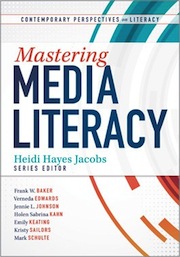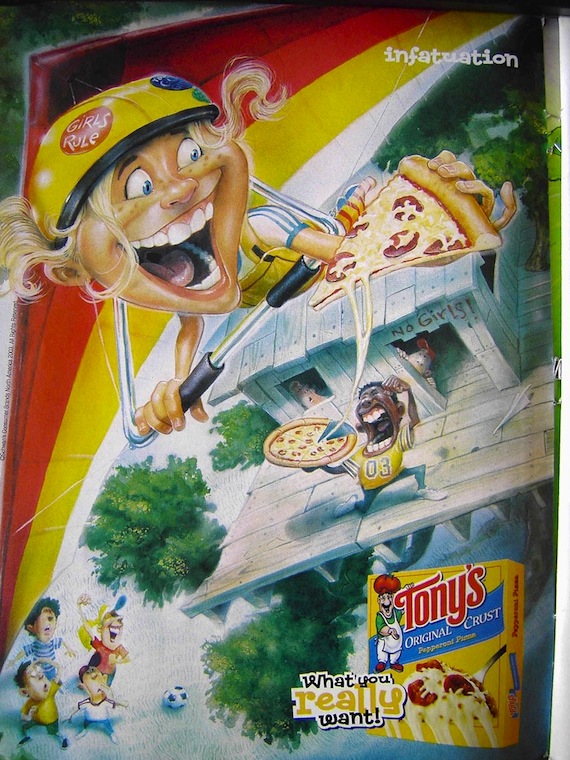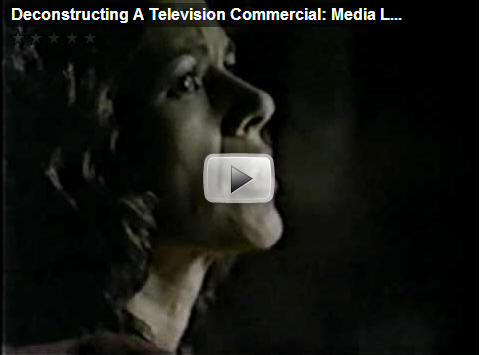Close Reading of Advertising Promotes Critical Thinking
This is the third article in a four-part series by expert Frank Baker, drawing connections between the Common Core’s emphasis on “close reading” and media literacy. Also see Part 1 (media text) and Part 2 (photography).

Advertising: it’s everywhere. As media literacy educators work to engage students in conversations and study about commercial marketing, we have to encompass more advertising in more mediums (radio, TV, film, internet, newspapers, magazines, social media) than ever before.
In the pre-Common Core era, we were teaching students “techniques of persuasion.” Now the terminology has shifted to “argument.” The study of advertising fits nicely in many CC standards, including these two:
▶ Speaking & Listening Standards (Grade 8)
Analyze the purpose of information presented in diverse media and formats (e.g., visually, quantitatively, orally) and evaluate the motives (e.g., social, commercial, political) behind its presentation.
▶ College and Career Readiness Anchor Standards for Reading (Integration)
Delineate and evaluate the argument and specific claims in a text, including the validity of the reasoning as well as the relevance and sufficiency of the evidence.
Deconstructing ads through the school year
As a media education consultant, I have used a number of print and non-print ads in my teacher and student workshops. As a result, I created these advertising resource web pages to assist teachers who may want to engage students in advertising analysis, deconstruction and production.
For example, during the holiday time of year (November-December), upper elementary teachers might want to take advantage of the resources on toy ads. The start of the New Year is good time for secondary teachers to consider engaging their students in examining all the hoopla around Super Bowl ads — or the marketing messages that Hollywood producers use to promote Oscar-worthy films.
During Drug-Free Schools week, educators might want to have students analyze smoking imagery and tobacco advertising.

Some teaching strategies
I recommend that teachers start first with print ads, taken from magazines or newspapers. (After students excel at these, you can move on to non-print ads.) I teach that ads are “informational texts” and there are many ways to approach learning about them. The media literacy approach recommends that we challenge our students to think about:
• how an ad was constructed;
• for what audience(s);
• using which techniques; and
• who benefits from the message and its placement.
An art approach might involve studying layout, design, color, font and image composition.
For ELA and social studies teachers: Think about the words “purpose” and “motive” in the CC 8th grade standard. Ask students “what is the purpose of advertising?” and most will probably say to sell something. But I would argue that advertising is much more than simply selling.
More than anything, it’s about persuasion. Challenge students to create a log of all the ads they come into contact with during a typical day. Where did they see the ads? What do they recall? Are they influenced by ads? (Just ask them to explain the logos on their clothes.)
Deconstructing a pizza ad
Here is an advertisement for pizza, taken from a magazine aimed at the tween audience.
I introduce this ad by recommending that my audience:
• read every word on the page (even words in small font)
• make a list of all of the images
• consider the layout, color, design, and font
I advise students to raise their hands if they come across any unfamiliar words.
Speaking of words, did you notice those words in small font running along the left margin of the ad? That might be something important, and I like to get my audience to rotate the ad horizontally in order to read those small words.
So how else might we use this ad? We might ask students to identify the slogan; tell the story; notice the colors and other attention-getters; identify the point-of-view; who has the power; how does your eye move as you read the ad?
We can take the ad deconstruction even further by challenging students to consider these questions:
– who created this ad (the answer is not on the ad)
– what is the purpose of the ad?
– who is the audience for the ad: what are the clues;
– what magazine would you expect to publish an ad like this?
– what is omitted and why? and where can students find the answers to what’s missing?
(Here is a lesson plan I did for a South Carolina project, using this pizza ad. You can find all the background information about the ad you need. There’s also an 8.5 x 11 download – large enough to read all the small print.)
After your students have gained experience at analyzing ads, you should consider giving them opportunities to create ads. (Creation sits atop the list of higher order thinking skills in this proposed Bloom’s Digital Taxonomy.)
Using VoiceThread
Several years ago, I discovered a middle grades teacher who was using Voicethread to engage her students in ad analysis and deconstruction. Take a look and listen to how her students responded to the NIKE ad and the questions she posed:
Source: http://ed.voicethread.com/share/663006
(If you don’t see the Voicethread window above, you’re likely using an Apple iOS device and need to install the Voicethread app.)
Deconstructing commercials
Where print ads rely on words and pictures, television commercials rely on words, sounds and moving images. Commercials are more complex because there are so many elements to study and analyze.
Most of us have never been inside an advertising agency (no, “Mad Men” on AMC does not count). But it is inside ad agencies that ads are born. I wish more educators embraced the work product of ad companies as they engage students in the study and investigation of the persuasion business. (Books by and about David Ogilvy, one inspiration for Mad Men, can be illuminating.)
Despite the fact that, thanks to technology, we now have more opportunities to skip ads on television and streaming media, commercials remain an inevitable part of our lives. In fact, ask students what is the purpose of TV and they’re not likely to know that it is, with few exceptions, to deliver an audience….us…to advertisers through the “allure” of programming.
Writing ad scripts

Before showing students commercials, you might begin by having them write their own commercials or PSA (Public Service Announcements). A simple two-column script has AUDIO and VIDEO. If students try their hand at writing a commercial, since they’re not shooting the video they should concentrate on AUDIO (what is being said and heard). Audio includes not only the narration (on camera or voice-over), but also the music and sound effects.
Scriptwriting alone is a valuable CC-related activity, and it can be made more valuable by also having your students “storyboard” (draw) the action that the script describes. ( I spotted several introductory storyboard videos on TeacherTube.)
Should you decide to let students work on video, remember, it is both the script and the storyboard that must precede production. So before your students turn on those cameras, make sure they’ve completed the first two steps.
 Studying commercials
Studying commercials
Choose a commercial spot that you think will resonate with your students. For younger students, I recommend a toy commercial; for older students it might be one for fast food, diet products, or a candidate running for office. Plan to show the spot more than once: that way, students will pick up elements they may have missed on first viewing.
One element that teachers can call student attention to is production techniques. How might understanding camerawork, lighting, sound, editing, etc. help students understand how these elements imply meaning?
My lesson plan “Deconstructing Television Commercials” has a link to a 60-second commercial (above) as well as questions and additional resources to simulate discussion. It’s a cellphone ad from earlier days, when everyone didn’t routinely have such a device in their pocket or purse. Students can think of what that might have been like, and how the atmosphere created in this commercial, complete with howling wolves and a dark stranger, might have boosted sales.
In the fourth and final article in this series. Frank Baker will explore the connection between close reading and the language of moving images.
Part 1: Close Reading and What It Means for Media Literacy
Part 2: Close Reading: Visual Literacy through Photography
Part 4: How to Close-Read the Language of Film



 Studying commercials
Studying commercials































